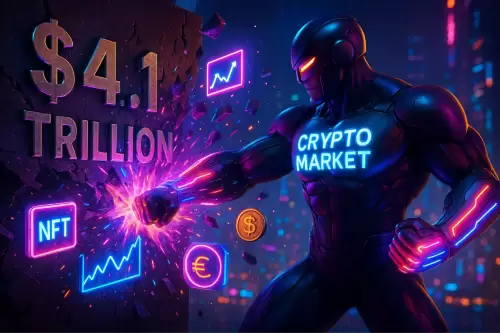 |
|
 |
|
 |
|
 |
|
 |
|
 |
|
 |
|
 |
|
 |
|
 |
|
 |
|
 |
|
 |
|
 |
|
 |
|
Articles d’actualité sur les crypto-monnaies
Can You Stake Bitcoin Like Ethereum or Solana?
Apr 30, 2025 at 05:19 pm

Crypto users often hear about staking. Many platforms promote it as a way to earn passive income. Especially during the 2021 bull market, when Celsius, Voyager, and Nexo advertised high interest rates and simple user interfaces, this narrative flourished.
But when it comes to Bitcoin, the answer is not that simple. Can you really stake BTC like ETH or SOL?
The short answer is no. But there’s more to it. This article will explain everything you need to know about Bitcoin staking.
What Is Crypto Staking?
Staking is a process of locking up your crypto in order to earn rewards and support the blockchain. It helps keep the network secure.
When you stake a coin, you essentially allow the network to use your tokens. In return, you receive rewards, which can be compared to interest from a savings account.
However, staking is only possible on some blockchains, those that use Proof-of-Stake, or PoS. This system was introduced later and is different from the original Proof-of-Work, PoW, which Bitcoin uses.
In PoS, the more coins a user has staked, the higher their chance of being selected to validate transactions. And when they validate, they earn rewards. The process is fully automated; users simply need to deposit their coins and wait.
For example, Ethereum transitioned from PoW to PoS in 2022, an upgrade called “The Merge.” After this change, users could lock up their ETH and earn about 3% to 5% in rewards per year.
Other coins that support staking include Cardano, Solana, and Polkadot.
Why Bitcoin Can’t Be Staked Natively
Bitcoin uses a different system—Proof-of-Work. This was the first method applied to secure blockchains. Bitcoin’s creator, Satoshi Nakamoto, chose this system in 2009.
In PoW, powerful computers solve complex mathematical problems in a race against each other. These machines are called miners. The first miner to solve the puzzle gets to add a new block to the blockchain. As a reward, they receive a certain amount of Bitcoin.
This means that only miners get Bitcoin rewards. If you hold BTC in your wallet, you don’re not earning anything just for holding it.
PoW and PoS work very differently. PoS uses coin balances to secure the network, while PoW uses computing power.
That’s why Bitcoin has no built-in staking function. There is no way to earn rewards by locking up your Bitcoin on the blockchain itself.
Some people might confuse mining and staking, but they are not the same. Staking supports PoS networks, while mining supports PoW networks like Bitcoin.
“Bitcoin Staking” Services: What Are They Really?
Many platforms offer “Bitcoin staking,” but this term is often used loosely and can be misleading. In most cases, you’re not actually staking but rather lending your Bitcoin to someone else.
One way to do this is through centralized platforms like Binance Earn, Nexo, or other crypto lenders.
These platforms take your Bitcoin and lend it to borrowers, promising to pay you a fixed interest rate on your deposit.
This process is not true staking and is more like a bank deposit, where you give up control of your Bitcoin and the platform manages it. If something goes wrong with the platform, you may lose your funds.
Another method involves using Wrapped Bitcoin, or WBTC, which is Bitcoin that has been tokenized on another blockchain, like Ethereum.
WBTC is backed 1:1 by real Bitcoin and can be used in the same way as any other token on the new chain. For example, if you have WBTC in your wallet, you can provide liquidity for Aave or yield farm on Curve with it.
This allows you to earn yield in DeFi apps just like you would with Ethereum or other tokens.
But again, this is not native Bitcoin staking; you’re using a different token, on a different network, and it comes with risk.
There have been issues in the past with platforms like Celsius Network or Voyager Digital, both of which went bankrupt in 2022.
Users lost access to billions of dollars in funds as both companies went bankrupt, highlighting the potential pitfalls of "staking" through lending or centralized platforms.
Also, keep in mind that Wrapped tokens depend on the company or platform that issues them. If the platform fails, you may not be able to redeem your BTC.
Always read the terms of service before you deposit your coins. Some platforms may use your funds for trading or lending without clear notice in their legal documents.
And in most cases, you will no longer have control over your Bitcoin once you deposit it with a third party.
Safe Alternatives to Bitcoin Staking
If you want to stake Bitcoin securely in order to earn from it, there are other options, but none of them are risk-free.
One
Clause de non-responsabilité:info@kdj.com
Les informations fournies ne constituent pas des conseils commerciaux. kdj.com n’assume aucune responsabilité pour les investissements effectués sur la base des informations fournies dans cet article. Les crypto-monnaies sont très volatiles et il est fortement recommandé d’investir avec prudence après une recherche approfondie!
Si vous pensez que le contenu utilisé sur ce site Web porte atteinte à vos droits d’auteur, veuillez nous contacter immédiatement (info@kdj.com) et nous le supprimerons dans les plus brefs délais.
-

-

- La prévente des blocs de blocage a passé 371 millions de dollars: Fuels de collecte de fonds Fuels Crypto Sensation
- Aug 13, 2025 at 10:12 am
- Le succès de la prévente de Blockdag, dépassant 371 millions de dollars, signale une forte confiance des investisseurs et un avenir prometteur pour ce projet de blockchain innovant. Est-ce la crypto supérieure pour 2025?
-

-

-

- Bitcoin, Bitmax et demande institutionnelle: une nouvelle ère d'investissement cryptographique
- Aug 13, 2025 at 08:58 am
- Explorez comment l'expansion du bitcoin de BitMax et l'adoption institutionnelle plus large sont de remodeler le paysage cryptographique, tirée par des investissements stratégiques et des réglementations évolutives.
-

- Solana, Roam et Airdrops: Quel est le buzz en 2025?
- Aug 13, 2025 at 08:36 am
- Plongez dans le dernier sur Solana, Roam et Airdrops. D'OSL HK permettant au commerce de détail Solana de traduire aux stratégies aériennes innovantes de ROAM, découvrez les tendances clés en train de façonner le paysage cryptographique.
-

-

-

- Drame des dépôts et retraits d'Odinfun: un lancement de Memecoin sous le feu
- Aug 13, 2025 at 08:03 am
- Odin.fun, un Launchpad Memecoin LaunchoN, basé à Bitcoin, fait face à des craintes de violation de sécurité après une forte baisse des dépôts, conduisant à des échanges et à des retraits en suspens. Peut-il reconstruire la confiance?






























































